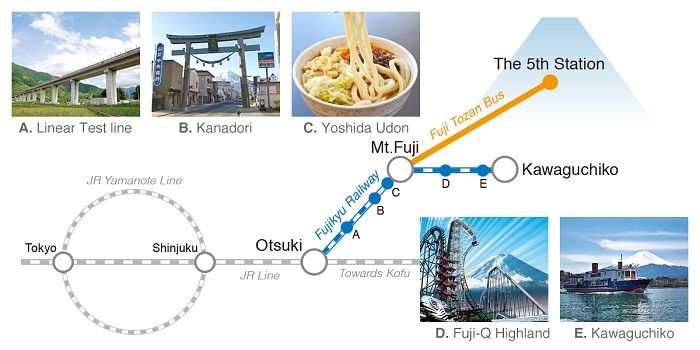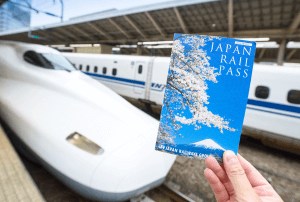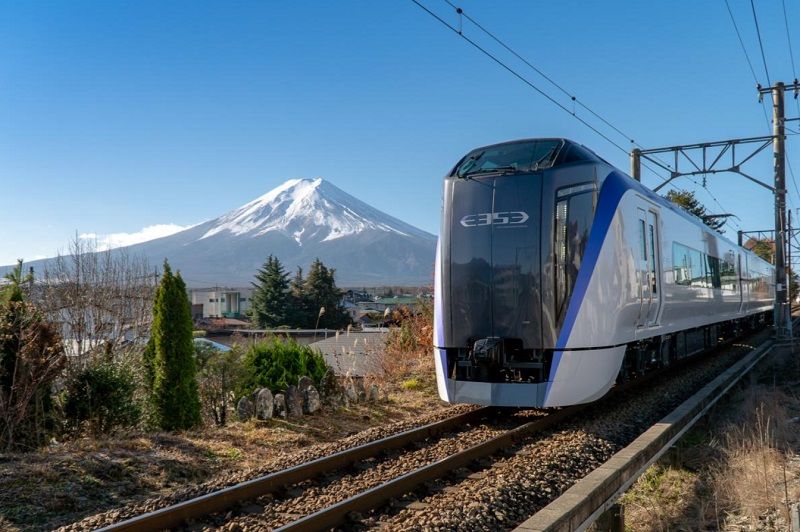Mount Fuji is a breathtaking destination which is right at the top of many visitors’ bucket lists. It offers sensational views which have inspired Japanese art for centuries but, at over 3,500 meters above sea level, it has not been the easiest place to get to!
The implementation of the Fuji Excursion train has made it much easier. It connects Shinjuku Station (Tokyo) directly to Mt Fuji which saves travelers a great deal of time as well as the hassle of making multiple changes.
This guide will tell you everything you need to know about the limited express Fuji Excursion train including the route, timetable, prices, making seat reservations, and whether you can use your JR Pass on the service.
Table of Contents
Fuji Excursion service
The service is operated by E353 series trains which start the journey with 3 cars (numbered 1 to 3). However, between Otsuki and Shinjuku, the train couples with another 8 more cars (numbered 4 to 12).
The full journey from Shinjuku Station will only take an hour and 55 minutes marking a huge timesaving for visitors. At the moment, 4 trains run daily on both weekdays and Saturdays, Sundays and holidays.
The Fuji Excursion makes several stops at convenient stops for tourists including Otsuki (where you can see the world’s fastest train at the Yamanashi Prefectural Maglev Exhibition Center), Fujikyu Highland (Japan’s largest amusement park) and Kawaguchiko (next to Lake Kawaguchi).
Route and stops
The Fuji Excursion is a regular limited express service which runs between Shinjuku on the Chuo Line and Kawaguchiko (Lake Kawaguchi) on the Fujikyuko Line. There are two round trips a day which stop at the following stations:
- Shinjuku
- Tachikawa
- Hachiōji
- Ōtsuki
- Tsuru-bunkadaigaku-mae
- Shimo-Yoshida
- Mount Fuji
- Fujikyu Highland
- Kawaguchiko
The last 3 stations (Mount Fuji, Fujikyu-Highland and Kawaguchiko) serve as gateway stations for Mount Fuji and the Fuji Five Lakes.

Tickets and prices
Passengers can buy tickets for the Fuji Excursion from the JR ticket counter, a JR ticket machine or online. Here is a list of the prices on the Fuji Excrusion limited express (for one-way trips):
| Fuji Excursion prices | ||
|---|---|---|
| Route | Adult price | Child price |
| Shinjuku – Kawaguchiko | 4,130 yen | 2, 060 yen |
| Shinjuku – Fujikyu Highland | 4, 060 yen | 3, 030 yen |
| Shinjuku – Mt. Fuji (Fujisan) | 4, 000 yen | 2, 000 yen |
| Shinjuku – Tsuru-bunkadaigaku-mae | 3,330 yen | 1,660 yen |
| Otsuki – Mt. Fuji, Fujikyu Highland, Kawaguchiko | 1,770 yen | 990 yen |


The JR Pass gives you unlimited access to transportation all around Japan for 7, 14, or 21 days, including Shinkansen.
A single ticket, huge savings.
How to buy tickets
Passengers can buy tickets for the Fuji Excursion from a JR ticket counter, a JR ticket machine or online.
If you have a Japan Rail Pass you can ride a part of the Fuji Excursion (Shinjuku – Otsuki) without needing an additional ticket.
However, JR Pass holders need to buy a ticket for the ‘Otsuki – Mount Fuji / Fujikyu Highland / Kawaguchiko’ section of the journey.
- Otsuki – Kawaguchiko: 1170 yen, 590 yen for children
- Express fare: 600 yen for adults; 400 yen for children
- Total: 1770 yen, 990 yen for children
Fuji Excursion timetable
Here is the current timetable for the Fuji Excursion trains.
| Fuji Excursion timetable from Tokyo | ||||
|---|---|---|---|---|
| Station | Fuji Excursion No. 3 | Fuji Excursion No. 7 | Fuji Excursion No. 11 | Fuji Excursion No. 15 |
| Chiba | 06:38 | – | – | – |
| Funabashi | 06:53 | – | – | – |
| Kinshicho | 07:08 | – | – | – |
| Shinjuku | 7:30 | 8:30 | 9:30 | 10:30 |
| Tachikawa | 7:52 | 8:57 | 10:42 | 8:37 |
| Hachioji | 8:02 | 9:07 | 10:07 | 10:53 |
| Otsuki | 8:40 | 9:42 | 10:42 | 11:36 |
| Tsuru Bunka University | 8:57 | 9:59 | 10:58 | 11:54 |
| Shimo-Yoshida | 9:13 | 10:14 | 11:15 | 12:09 |
| Mount Fuji (Fujisan) | 9:22 | 10:21 | 11:24 | 12:17 |
| Fujikyu Highland | 9:25 | 10:24 | 11:27 | 12:20 |
| Kawaguchiko | 9:28 | 10:27 | 11:30 | 12:22 |
Seat reservation
Passengers need to buy a supplementary ticket, as well as the basic ticket, to board the train. There are two types of these supplementary tickets: the reserved seat ticket and the unreserved seat ticket.
The reserved ticket allows a specific seat to be reserved. There is a lamp above each seat which indicates whether a seat is reserved or not.
A green light means a seat has been reserved, a red light signifies a seat in unreserved, and a yellow light shows that a seat has been reserved for a later part of the journey (passengers can sit in these seats but will have to give the seat up when the reserving passenger boards).
The unreserved seat ticket allows passengers to sit on any of the unreserved seats. If there are no unreserved seats available passengers with unreserved seats need to stand up for the journey.
